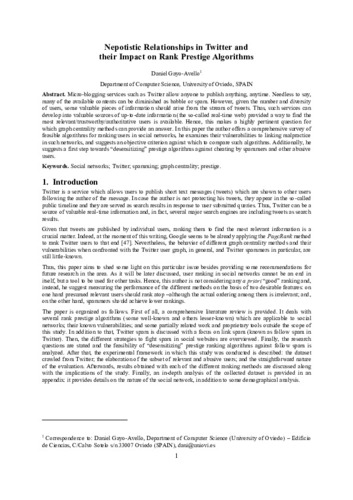Nepotistic relationships in Twitter and their impact on rank prestige algorithms
Autor(es) y otros:
Fecha de publicación:
Editorial:
Elsevier
Versión del editor:
Citación:
Descripción física:
Resumen:
Micro-blogging services such as Twitter allow anyone to publish anything, anytime. Needless to say, many of the available contents can be diminished as babble or spam. However, given the number and diversity of users, some valuable pieces of information should arise from the stream of tweets. Thus, such services can develop into valuable sources of up-to-date information (the so-called real-time web) provided a way to find the most relevant/trustworthy/authoritative users is available. Hence, this makes a highly pertinent question for which graph centrality methods can provide an answer. In this paper the author offers a comprehensive survey of feasible algorithms for ranking users in social networks, he examines their vulnerabilities to linking malpractice in such networks, and suggests an objective criterion against which to compare such algorithms. Additionally, he suggests a first step towards ―desensitizing‖ prestige algorithms against cheating by spammers and other abusive user
Micro-blogging services such as Twitter allow anyone to publish anything, anytime. Needless to say, many of the available contents can be diminished as babble or spam. However, given the number and diversity of users, some valuable pieces of information should arise from the stream of tweets. Thus, such services can develop into valuable sources of up-to-date information (the so-called real-time web) provided a way to find the most relevant/trustworthy/authoritative users is available. Hence, this makes a highly pertinent question for which graph centrality methods can provide an answer. In this paper the author offers a comprehensive survey of feasible algorithms for ranking users in social networks, he examines their vulnerabilities to linking malpractice in such networks, and suggests an objective criterion against which to compare such algorithms. Additionally, he suggests a first step towards ―desensitizing‖ prestige algorithms against cheating by spammers and other abusive user
ISSN:
Identificador local:
20131138
Colecciones
- Artículos [37548]
- Informática [875]
Ficheros en el ítem




